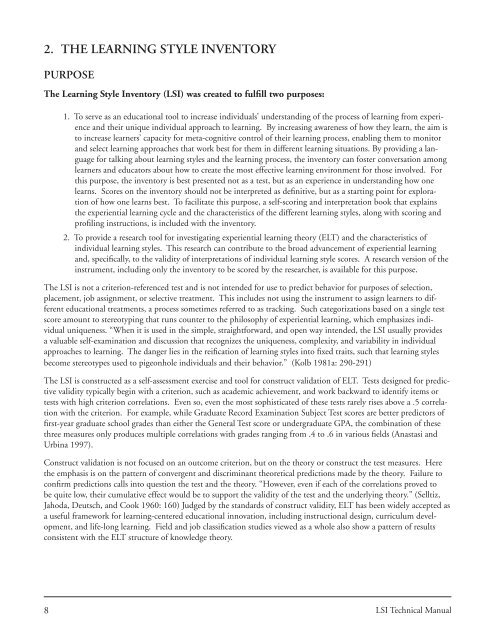The Kolb Learning Style Inventory—Version 3.1 2005 - Whitewater ...
The Kolb Learning Style Inventory—Version 3.1 2005 - Whitewater ...
The Kolb Learning Style Inventory—Version 3.1 2005 - Whitewater ...
Create successful ePaper yourself
Turn your PDF publications into a flip-book with our unique Google optimized e-Paper software.
2. THE LEARNING STYLE INVENTORY<br />
PURPOSE<br />
<strong>The</strong> <strong>Learning</strong> <strong>Style</strong> Inventory (LSI) was created to fulfi ll two purposes:<br />
1. To serve as an educational tool to increase individuals’ understanding of the process of learning from experience<br />
and their unique individual approach to learning. By increasing awareness of how they learn, the aim is<br />
to increase learners’ capacity for meta-cognitive control of their learning process, enabling them to monitor<br />
and select learning approaches that work best for them in different learning situations. By providing a language<br />
for talking about learning styles and the learning process, the inventory can foster conversation among<br />
learners and educators about how to create the most effective learning environment for those involved. For<br />
this purpose, the inventory is best presented not as a test, but as an experience in understanding how one<br />
learns. Scores on the inventory should not be interpreted as defi nitive, but as a starting point for exploration<br />
of how one learns best. To facilitate this purpose, a self-scoring and interpretation book that explains<br />
the experiential learning cycle and the characteristics of the different learning styles, along with scoring and<br />
profi ling instructions, is included with the inventory.<br />
2. To provide a research tool for investigating experiential learning theory (ELT) and the characteristics of<br />
individual learning styles. This research can contribute to the broad advancement of experiential learning<br />
and, specifi cally, to the validity of interpretations of individual learning style scores. A research version of the<br />
instrument, including only the inventory to be scored by the researcher, is available for this purpose.<br />
<strong>The</strong> LSI is not a criterion-referenced test and is not intended for use to predict behavior for purposes of selection,<br />
placement, job assignment, or selective treatment. This includes not using the instrument to assign learners to different<br />
educational treatments, a process sometimes referred to as tracking. Such categorizations based on a single test<br />
score amount to stereotyping that runs counter to the philosophy of experiential learning, which emphasizes individual<br />
uniqueness. “When it is used in the simple, straightforward, and open way intended, the LSI usually provides<br />
a valuable self-examination and discussion that recognizes the uniqueness, complexity, and variability in individual<br />
approaches to learning. <strong>The</strong> danger lies in the reifi cation of learning styles into fi xed traits, such that learning styles<br />
become stereotypes used to pigeonhole individuals and their behavior.” (<strong>Kolb</strong> 1981a: 290-291)<br />
<strong>The</strong> LSI is constructed as a self-assessment exercise and tool for construct validation of ELT. Tests designed for predictive<br />
validity typically begin with a criterion, such as academic achievement, and work backward to identify items or<br />
tests with high criterion correlations. Even so, even the most sophisticated of these tests rarely rises above a .5 correlation<br />
with the criterion. For example, while Graduate Record Examination Subject Test scores are better predictors of<br />
fi rst-year graduate school grades than either the General Test score or undergraduate GPA, the combination of these<br />
three measures only produces multiple correlations with grades ranging from .4 to .6 in various fi elds (Anastasi and<br />
Urbina 1997).<br />
Construct validation is not focused on an outcome criterion, but on the theory or construct the test measures. Here<br />
the emphasis is on the pattern of convergent and discriminant theoretical predictions made by the theory. Failure to<br />
confi rm predictions calls into question the test and the theory. “However, even if each of the correlations proved to<br />
be quite low, their cumulative effect would be to support the validity of the test and the underlying theory.” (Selltiz,<br />
Jahoda, Deutsch, and Cook 1960: 160) Judged by the standards of construct validity, ELT has been widely accepted as<br />
a useful framework for learning-centered educational innovation, including instructional design, curriculum development,<br />
and life-long learning. Field and job classifi cation studies viewed as a whole also show a pattern of results<br />
consistent with the ELT structure of knowledge theory.<br />
8 LSI Technical Manual


